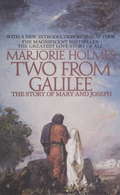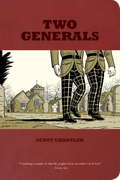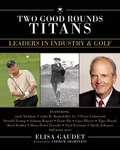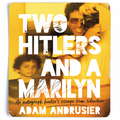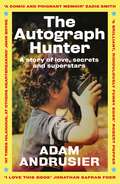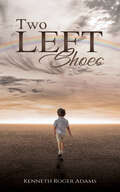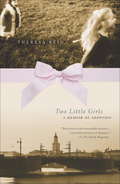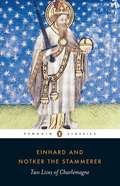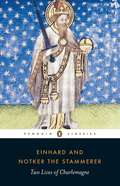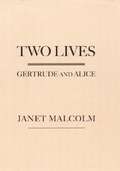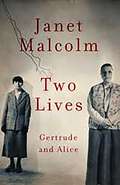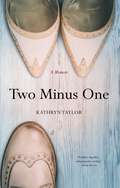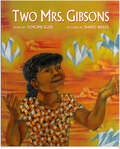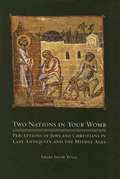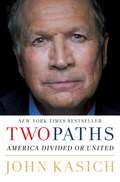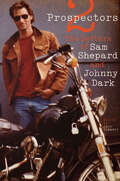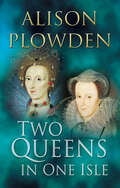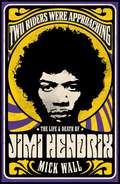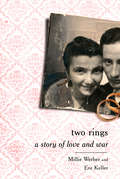- Table View
- List View
Two From Galilee: The Story Of Mary And Joseph
by Marjorie HolmesHere from Marjorie Holines, one of the most beloved authors of our day, is the extraordinary bestselling novel that tells the story of Mary and Joseph as it has never been told before--the greatest love story of all.This is the story of two real people whose lives were touched by God: two people chosen by God to provide an earthly home for His Son. Here are Mary and Joseph-a teenage girl and a young carpenter-alone, frightened, in love, faced with family conflict, a hostile world and an awesome responsibility. It is a story for young and old alike; for everyone who finds the Christmas tale a source of timeless beauty and wonder, a compassionate, emotional novel of divine love
Two Generals
by Scott ChantlerA beautifully illustrated and poignant graphic memoir that tells the story of World War II from an Everyman's perspective. In March of 1943, Scott Chantler's grandfather, Law Chantler, shipped out across the Atlantic for active service with the Highland Light Infantry of Canada, along with his best friend, Jack, a fellow officer. Not long afterward, they would find themselves making a rocky crossing of the English Channel, about to take part in one of the most pivotal and treacherous military operations of World War II: the Allied invasion of Normandy. Two Generalstells the story of what happened there through the eyes of these two young men -- not the celebrated military commanders or politicians we often hear about, but everyday heroes who risked their lives for the Allied cause. Meticulously researched and gorgeously illustrated,Two Generalsis a harrowing story of battle and a touching story of friendship -- and a vital and vibrant record of unsung heroism.
Two Good Rounds Titans: Leaders in Industry & Golf
by Elisa Gaudet Andrew SharplessTwo Good Rounds Titans: Leaders in Industry & Golf is the third book in the Two Good Rounds series. This book continues the exploration of golf and the feel-good golf lifestyle by navigating the connection between golf and business as conveyed by an array of successful leaders from a variety of industries. Two Good Rounds Titans highlights different business leaders and their passion for business and golf. It explores what led to their success in their respective industries and how golf has played a role in their business and personal lives. All of these leaders have reached the top of their industry and own their own golf course, so they have gone beyond playing golf to being intricately involved in the golf industry. The book also explores well-known professional touring golfers who have leveraged their careers and turned them into brands and businesses that expand beyond their competitive playing purse winnings.Two Good Rounds Titans is a tribute to triumphant business people and pro golfers alike. Like a great nineteenth hole or favorite clubhouse, this book provides a means by which these individuals can share their stories of success and passion with family and friends.
Two Hitlers and a Marilyn: An autograph hunter's escape from suburbia
by Adam Andrusier"I'd managed to puncture a hole between our universe and the parallel one where all the celebrities lived."'The zaniest book I've read in eons. Andrusier is a fresh new voice and more importantly he's funny as hell.'GARY SHTEYNGARTAdam Andrusier spent his childhood in pursuit of autographs. After writing to every famous person he could think of, from Frank Sinatra to Colonel Gaddafi, he soon jostled with the paparazzi at stage doors and came face-to-face with the most famous people on the planet.For young Adam, autographs were a backstage pass to a world beyond his chaotic family home in Pinner, and his Holocaust-obsessed father. They provided a special connection to a world of glamour and significance lying just beyond his reach.But as Adam turned from collector to dealer, learning how to spot a fake from the real deal, he discovered that in life, as in autographs, not everything is as it first appears. When your obsession is a search for the authentic, what happens when you discover fraudulence in your own family?Two Hitlers and a Marilyn is a hilarious and moving account of discovering that idols are mortals. It's a story of growing up, forgiveness and discovering a place in the world.'I love this book. It is wise, funny, surprising, touching, and wonderful company.'JONATHAN SAFRAN FOER(P)2021 Headline Publishing Group Limited
Two Hitlers and a Marilyn: An autograph hunter's escape from suburbia
by Adam Andrusier"I'd managed to puncture a hole between our universe and the parallel one where all the celebrities lived."'The zaniest book I've read in eons. Andrusier is a fresh new voice and more importantly he's funny as hell.' GARY SHTEYNGART Adam Andrusier spent his childhood in pursuit of autographs. After writing to every famous person he could think of, from Frank Sinatra to Colonel Gaddafi, he soon jostled with the paparazzi at stage doors and came face-to-face with the most famous people on the planet. For young Adam, autographs were a backstage pass to a world beyond his chaotic family home in Pinner, and his Holocaust-obsessed father. They provided a special connection to a world of glamour and significance lying just beyond his reach. But as Adam turned from collector to dealer, learning how to spot a fake from the real deal, he discovered that in life, as in autographs, not everything is as it first appears. When your obsession is a search for the authentic, what happens when you discover fraudulence in your own family? Two Hitlers and a Marilyn is a hilarious and moving account of discovering that idols are mortals. It's a story of growing up, forgiveness and discovering a place in the world.'I love this book. It is wise, funny, surprising, touching, and wonderful company.' JONATHAN SAFRAN FOER
Two Kisses for Maddy: A Memoir of Loss & Love
by Matt LogelinMatt and Liz Logelin were high school sweethearts. After years of long-distance dating, the pair finally settled together in Los Angeles, and they had it all: a perfect marriage, a gorgeous new home, and a baby girl on the way. Liz's pregnancy was rocky, but they welcomed Madeline, beautiful and healthy, into the world on March 24, 2008. Just twenty-seven hours later, Liz suffered a pulmonary embolism and died instantly, without ever holding the daughter whose arrival she had so eagerly awaited. Though confronted with devastating grief and the responsibilities of a new and single father, Matt did not surrender to devastation; he chose to keep moving forward-- to make a life for Maddy. In this memoir, Matt shares bittersweet and often humorous anecdotes of his courtship and marriage to Liz; of relying on his newborn daughter for the support that she unknowingly provided; and of the extraordinary online community of strangers who have become his friends. In honoring Liz's legacy, heartache has become solace.
Two Left Shoes
by Kenneth Roger AdamsDiscover the story of a determined mother who fought hard to keep her family together during wartime and its aftermath, with hardly any support from others. The battle didn’t end with the war; it extended into my own life. Growing up in poverty, I faced my own set of challenges that made every step towards success feel like a steep climb. However, these trials pushed me to strive harder and sparked a desire to help others. This tale follows our family’s journey through hard times, my own fight to achieve my goals, and how these experiences ignited a passion for giving back.
Two Little Girls: A Memoir of Adoption
by Theresa ReidIn Chicago, Theresa Reid and her husband had lucrative careers and a beautiful home. What was missing from their lives was children. But they knew in Eastern Europe there were children who were missing parents -- and they set out to find their family. There was self-doubt and gut-wrenching fear, mountains of paperwork and nerve-racking interviews, agonizing choices and false starts. There was the painful awareness of thousands of children languishing in poorly-funded orphanages, waiting for someone to embrace them and bring them home. And there were Byzantine bureaucracies and poverty-stricken conditions in the former Soviet Republic-where, beyond the borders they crossed and the obstacles they navigated, two little girls waited. This is Theresa Reid's account of how Natalie and Lana came to be her daughters -- a journey that travels not only to Moscow and Kiev but into the deepest parts of a mother's heart. She addresses the issues that arise for many an adoptive parent-including the guilt over taking children away from their roots, the unknowable mysteries of her daughters' earliest childhoods, and the slow, stumbling steps toward trust and tenderness that played out between them.
Two Lives of Charlemagne
by Einhard Notker The StammererCharlemagne---known as the father of Europe---was one of the most powerful and dynamic of all medieval rulers. The biographies brought together here provide a rich and varied portrait of the king from two perspectives: that of Einhard, a close friend and adviser, and of Notker, a monastic scholar and musician writing fifty years after Charlemagne's death. Translated, edited and with notes by David Ganz.
Two Lives of Charlemagne: The Biography, History And Legend Of King Charlemagne, Ruler Of The Frankish Empire (hardcover)
by Einhard Notker the StammererEinhard's Life of Charlemagne is an absorbing chronicle of one of the most powerful and dynamic of all medieval rulers, written by a close friend and adviser. In elegant prose it describes Charlemagne's personal life, details his achievements in reviving learning and the arts, recounts his military successes and depicts one of the defining moments in European history: Charlemagne's coronation as emperor in Rome on Christmas Day 800AD. By contrast, Notker's account, written some decades after Charlemagne's death, is a collection of anecdotes rather than a presentation of historical facts.
Two Lives: Gertrude and Alice
by Janet MalcolmHow had the pair of elderly Jewish lesbians survived the Nazis? Janet Malcolm asks at the beginning of this extraordinary work of literary biography and investigative journalism. The pair, of course, is Gertrude Stein, the modernist master "whose charm was as conspicuous as her fatness" and "thin, plain, tense, sour" Alice B. Toklas, the "worker bee" who ministered to Stein's needs throughout their forty-year expatriate "marriage. " As Malcolm pursues the truth of the couple's charmed life in a village in Vichy France, her subject becomes the larger question of biographical truth. "The instability of human knowledge is one of our few certainties," she writes. The portrait of the legendary couple that emerges from this work is unexpectedly charged. The two world wars Stein and Toklas lived through together are paralleled by the private war that went on between them. This war, as Malcolm learned, sometimes flared into bitter combat. Two Lives is also a work of literary criticism. "Even the most hermetic of [Stein's] writings are works of submerged autobiography," Malcolm writes. "The key of 'I' will not unlock the door to their meaning-you need a crowbar for that-but will sometimes admit you to a kind of anteroom of suggestion. " Whether unpacking the accessible Autobiography of Alice B. Toklas, in which Stein "solves the koan of autobiography," or wrestling with The Making of Americans, a masterwork of "magisterial disorder," Malcolm is stunningly perceptive.
Two Lives: Gertrude and Alice
by Janet MalcolmTwo Lives is Janet Malcolm's stunning portrait of a legendary couple: Gertrude Stein, the modernist master, and Alice B Toklas, the 'worker bee' who ministered to Stein's needs throughout their forty-year expatriate 'marriage'. As Malcolm pursues the truth of the couple's charmed life in a village in Vichy France her subject becomes the larger question of biographical truth. 'The instability of human knowledge is one of our few certainties,' she writes. The portrait of their relationship that emerges is unexpectedly charged. The two world wars Stein and Toklas lived through together are paralleled by the private war that went on between them. This war, as Malcolm learned, sometimes flared into bitter combat. Janet Malcolm is at her finest in this extraordinary work of literary biography and investigative journalism.
Two Men and a Car: Franklin Roosevelt, Al Capone, And A Cadillac V-8
by Michael GarlandIt is December 8, 1941, the day after the Japanese attack on Pearl Harbor, and President Franklin Delano Roosevelt leads a nation in crisis. He must make a speech to a joint session of Congress that will build support for America’s entry to World War II, but to do that he needs an armored vehicle in which to make the short trip from the White House to the Capitol Building. According to legend, the car Roosevelt rode in that day, borrowed from the FBI’s impound lot, was an armored Cadillac V-8 built for gangster Al Capone in the late 1920s to shield himself from enemies. Is the legend true, or is it an American tall tale in the tradition of Paul Bunyan or John Henry? Either way, it’s an ideal vehicle to compare and contrast the lives of two American men who grew up within miles of one another: one a great president, the other an infamous villain. F&P Level Y
Two Minus One: A Memoir
by Kathryn TaylorKirkus Best Books of 2018 &“You can quit waiting for the other shoe to drop: I&’m in it for life.&” Those are the fateful, repeated words that help convince Kathryn Taylor to remarry, retire from her thirty-year profession, sell her home, and relocate in support of her new husband&’s career. But five years later, in a car packed with food she has carefully prepared to nourish her husband&’s dying brother, the other shoe does drop. Taylor&’s husband unexpectedly proclaims he is, &“done with the marriage and doesn&’t want to talk about it.&” With this, the life Taylor has come to know is over. Relying on the strength of a lifelong friend who refuses to let her succumb to the intense waves of grief, she slowly begins to find her way out of grief. Over the course of two years, through appointments with attorneys and therapists, purging shared belongings, and pushing herself to meet new people and do new things, Taylor not only regains a sense of control in her life, she also learns to enjoy the new life she has built, the friendships she&’s formed—and to savor her newfound strength.
Two Mrs. Gibsons
by Toyomi IgusTwo Mrs. Gibsons is author Toyomi Igus's tender and touching tribute to the two most important women in her life--her Japanese mother and her African American grandmother.From memories of her grandmother's big bear hugs to her mother's light down-filled comforter hugs, from listening to her grandmother's lively spirituals to her mother's soft lullabies, from playing with her grandmother's fancy going-to-a-Sunday-meetin' hats to trying on her mother's kimono, Toyomi celebrates the joys and rich diversity of growing up biracial.
Two Nations in Your Womb: Perceptions of Jews and Christians in Late Antiquity and the Middle Ages
by Barbara Harshav Israel Jacob Yuval Jonathan ChipmanTwo Nations in Your Womb confronts the historic relationship between Judaism and Christianity from a non-polemical orientation.
Two One Pony: An American Soldier's Year in Vietnam, 1969 (Stackpole Military History Series)
by Charles R CarrA thoughtful, reflective narrative of a reluctant soldier that captures the rhythms of life in war as well as the boredom and chaos of Vietnam. At the height of the Vietnam War, Charles Carr left graduate school to serve in the army in Southeast Asia, knowing that if he didn&’t, another man would go—and possibly die—in his place. He was assigned to the 2nd Battalion of the 47th Infantry (Mechanized) in the northern Mekong Delta for a tour of forcing himself through rice paddies and jungles all day and then setting ambushes at night. He concluded his tour with a stint at battalion headquarters. More than just a war memoir, this is the story of one soldier trying to find his way in uncertain times—and to survive his year in Vietnam.
Two Paths: America Divided or United
by John KasichWhen Ohio governor John Kasich ran for president, his powerful message of hope and togetherness struck a chord with American voters. In Two Paths: America Divided or United, he carries that message forward by reflecting on the tumultuous 2016 campaign, sharing his concerns for America and his hopes for our future, and sounding a clarion call to reason and purpose, humility and dignity, righteousness and calm.“The country never looked so grand and magnificent as it did from ten thousand feet,” he writes of his time on the campaign trail, “and it was always a thrilling, faith-affirming thing to look out our window and see the sun splashing across Bryce Canyon in Utah, or the lights of the New York skyline at night as we flew past the Statue of Liberty, or an open field in the heartland that ran as far as our eyes could see.... I’d look out and think what an honor it would be to lead this great nation, what a blessing.”To be sure, the full story of the 2016 Presidential race will be written over time, but to understand what it was to be on the front lines of one of the most divisive and corrosive campaign battlegrounds in history, readers won’t find a richer, more thoughtful firsthand account than this one—a frank, refreshing assessment of the American dynamic and a clear path we might follow toward a more promising tomorrow.As Governor Kasich reminds us in these pages, America is great because America is good—and because Americans have stayed true to who we are: one nation, under God, indivisible.
Two Prospectors: The Letters of Sam Shepard and Johnny Dark (Southwestern Writers Collection Series, Wittliff Collections at Texas State University)
by Sam Shepard Johnny DarkSam Shepard was arguably America’s finest working dramatist, as well as an accomplished screenwriter, actor, and director. Winner of a Pulitzer Prize, he wrote more than forty-five plays, including True West, Fool for Love, and Buried Child. Shepard also appeared in more than fifty films, beginning with Terrence Malick’s Days of Heaven, and was nominated for an Academy Award for his performance in The Right Stuff. Despite the publicity his work and life attracted, however, Shepard remained a strongly private man who said many times that he would never write a memoir. But he did write intensively about his inner life and creative work to his former father-in-law and housemate, Johnny Dark, who was Shepard’s closest friend, surrogate brother (they were nearly the same age), and even artistic muse. Two Prospectors gathers nearly forty years of correspondence and transcribed conversations between Shepard and Dark. In these gripping, sometimes gut-wrenching letters, the men open themselves to each other with amazing honesty. Shepard’s letters give us the deepest look we will ever get into his personal philosophy and creative process, while in Dark’s letters we discover insights into Shepard’s character that only an intimate friend could provide. The writers also reflect on the books and authors that stimulate their thinking, their relationships with women (including Shepard’s anguished decision to leave his wife and son—Dark’s stepdaughter and grandson—for actress Jessica Lange), personal struggles, and accumulating years. Illustrated with Dark’s candid, revealing photographs of Shepard and their mutual family across many years, as well as facsimiles of numerous letters, Two Prospectors is a compelling portrait of a complex friendship that anchored both lives for decades, a friendship also poignantly captured in Treva Wurmfeld’s film, Shepard & Dark.
Two Prospectors: The Letters of Sam Shepard and Johnny Dark (Southwestern Writers Collection Series, Wittliff Collections at Texas State University)
by Sam Shepard Johnny DarkThis collection shares decades of correspondence between the Pulitzer Prize-winning playwright and one of his closest friends—including personal photos.One of America&’s leading dramatists, as well as an accomplished actor, screenwriter, and director, Sam Shepard&’s legacy includes immortal plays like True West and Buried Child, as well as memorable film roles, including his Academy Award-nominated performance in The Right Stuff. Though Shepard remained an intensely private man, he wrote candidly about his life and work in letters to his close friend Johnny Dark. His former father-in-law, Dark became a surrogate brother to Shepard, and even an artistic muse. Two Prospectors gathers nearly forty years of correspondence and transcribed conversations between them.In these letters, the men open themselves to each other with gripping honesty. Shepard&’s letters give us the deepest look we will ever get into his personal philosophy and creative process, while in Dark&’s letters we discover insights into Shepard&’s character that only an intimate friend could provide. The writers also reflect on the books and authors that stimulate their thinking, their relationships with women (including Shepard&’s anguished decision to leave his wife and son for actress Jessica Lange), personal struggles, and accumulating years. Illustrated with Dark&’s photographs of Shepard and their mutual family across many years, as well as facsimiles of numerous letters, Two Prospectors is a compelling portrait of a complex friendship that anchored both lives for decades, a friendship also poignantly captured in Treva Wurmfeld&’s film, Shepard & Dark.
Two Queens in One Isle: The Deadly Relationship of Elizabeth I and Mary Queen of Scots
by Alison PlowdenThe relationship between Queen Elizabeth I of England and her cousin, Mary Queen of Scots, is one of the most complex, tempestuous and fascinating in history. United in blood but divided by religion, the two women were in some ways uniquely close; in others, poles apart. Championed by English Catholics as the rightful Queen of England, Mary was nevertheless given protection by her cousin after she was deposed amid outrage at her immoral behaviour. Rumours of papist plots involving Mary were rife and Elizabeth was put under extreme pressure to be rid of this dangerous threat to her sovereignty and to the Protestant church in England. After much reluctance and procrastination Elizabeth finally signed Mary's death warrant. Alison Plowden shows how political fear brought out the worst and yet the best in these women, and how history was overshadowed for centuries afterwards.
Two Riders Were Approaching: The Life & Death of Jimi Hendrix
by Mick WallJimmy was a down-at-heel guitarist in New York, relying on his latest lovers to support him while he tried to emulate his hero Bob Dylan. A black guy playing white rock music, he wanted to be all things to all people.But when Jimmy arrived in England and became Jimi, the cream of swinging London fell under his spell. It wasn't that Jimi could play with his teeth, play with his guitar behind his back. It was that he could really play.Journeying through the purple haze of idealism and paranoia of the sixties, Jimi Hendrix was the man who made Eric Clapton consider quitting, to whom Bob Dylan deferred on his own song 'All Along the Watchtower', who forced Miles Davis to reconsider his buttoned-down ways - and whose 'Star Spangled Banner' defined Woodstock. And when his star, which had burned so brightly, was extinguished far too young, his legend lived on in the music - and the intrigue surrounding his death. Eschewing the traditional rock-biography format, Two Riders Were Approaching is a fittingly psychedelic and kaleidoscopic exploration of the life and death of Jimi Hendrix - and a journey into the dark heart of the sixties. While the groupies lined up, the drugs got increasingly heavy and the dream of the sixties burned in the fire and blood of the Vietnam War, the assassination of Martin Luther King and the election of President Richard Nixon. Acclaimed writer Mick Wall, author of When Giants Walked the Earth, has drawn upon his own interviews and extensive research to produce an inimitable, novelistic telling of this tale - the definitive portrait of the Guitar God at whose altar other guitar gods worship.Jimi Hendrix's is a story that has been told many times before - but never quite like this.
Two Riders Were Approaching: The Life & Death of Jimi Hendrix
by Mick WallJimmy was a down-at-heel guitarist in New York, relying on his latest lovers to support him while he tried to emulate his hero Bob Dylan. A black guy playing white rock music, he wanted to be all things to all people.But when Jimmy arrived in England and became Jimi, the cream of swinging London fell under his spell. It wasn't that Jimi could play with his teeth, play with his guitar behind his back. It was that he could really play.Journeying through the purple haze of idealism and paranoia of the sixties, Jimi Hendrix was the man who made Eric Clapton consider quitting, to whom Bob Dylan deferred on his own song 'All Along the Watchtower', who forced Miles Davis to reconsider his buttoned-down ways - and whose 'Star Spangled Banner' defined Woodstock. And when his star, which had burned so brightly, was extinguished far too young, his legend lived on in the music - and the intrigue surrounding his death. Eschewing the traditional rock-biography format, Two Riders Were Approaching is a fittingly psychedelic and kaleidoscopic exploration of the life and death of Jimi Hendrix - and a journey into the dark heart of the sixties. While the groupies lined up, the drugs got increasingly heavy and the dream of the sixties burned in the fire and blood of the Vietnam War, the assassination of Martin Luther King and the election of President Richard Nixon. Acclaimed writer Mick Wall, author of When Giants Walked the Earth, has drawn upon his own interviews and extensive research to produce an inimitable, novelistic telling of this tale - the definitive portrait of the Guitar God at whose altar other guitar gods worship.Jimi Hendrix's is a story that has been told many times before - but never quite like this.
Two Rings: A Story of Love and War
by Millie Werber Eve KellerAt the heart of this wrenching memoir of a teenage girlOCOs wartime survival is something utterly unexpected: a love story that blazes briefly in a dark corner of occupied Poland"
